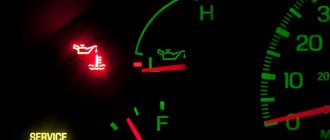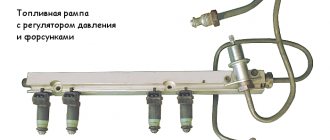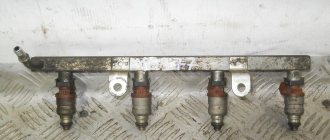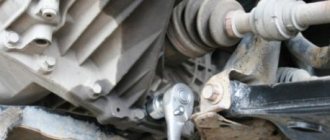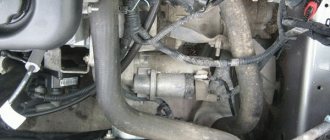Why do you need oil?
Is oil the lifeblood of the engine? This is not entirely true, of course, the comparison is very rough, but still, the engine will not function without oil (or it will, but not for a very long time). Modern motor oils lubricate and protect all rubbing parts, and these are pistons (with their rings), shafts, bearings, etc. Let's just say that good oil extends the life of the engine by many thousands of kilometers.
BUT oil must flow through the system, just like blood itself through human vessels, if the oil is simply poured in a pan and does not go to the rubbing parts - IT IS USELESS!
Lost oil pressure on Priora
| ignat 93 wrote: |
| I brought the car from the service station (AvtoVAZ). As expected, there was ice in the pan. I support the oil issue, but the point is that the car is still under warranty. They blamed me - I don’t warm it up enough and don’t drive it enough - a candence will form. It seemed to warm up normally. Well, up to 60-70 somewhere. In general, they replaced the filter and oil at my expense! They made me look like an idiot. one of the workers blurted out that I was not the first in these frosts and this is also a sore on the Priors! After the 2nd maintenance, I won’t take the car to them (it’s discolored). I'll change the oil and filter myself - they seem to be crap there!! Smile, for example, on the VAZ 21103 there were never any such problems. |
Looks like this is my case too. Lukoil GENESIS ARMORTECH oil, 5W40, was poured into the Priora in the summer, the mileage on it is about 1.5 thousand. I filled it myself. Recently there were frosts, about -20, without leaving, we warmed up the car (15-20 minutes), turned it off, then didn’t start it for several days. When they started to start it, the oil pressure light began to constantly burn, and the hydraulic valves began to crackle. After removing the oil filter, when cranking with the starter (DPKV was turned off), no oil came out of the pump. When we were looking for the cause of the loss of pressure, we removed the filter and did not notice anything unusual in the oil that spilled onto the filter, the oil was like oil. I installed a new filter, and nothing was pressed through with it (as it didn’t pour out without a filter, it didn’t work) They dragged the car with a tie into a pit, into the garage
We heated the sump with a 2 kW hairdryer to see if the oil would come out when the starter was turned, and removed the filter. Before starting, all the oil that spilled onto the filter from the system was in drops of water. Then we turned the starter, oil came out. We installed the filter, started the engine and after 5-10 minutes, the hydraulics were pumped and stopped rattling.
What builds up oil pressure in the system?
Everything is simple here - there is a special oil pump that takes oil from the engine sump and pumps it through the system.
It is usually installed in the engine sump and driven by special gears that the engine turns during operation. Oil begins to flow through many channels to the right places under pressure - this is the crankshaft and its bearings, the camshaft and its “bed”, pistons, and much more. It is the pump that is responsible for the pressure; if the pump stops, the pressure indicator will drop to zero. THIS CANNOT BE ALLOWED! Because the engine will not be lubricated at all, which will lead to instant breakdown, especially at high speeds.
BUT often the oil pump does not stop, but simply begins to pump worse, this indicates its wear, which is why you need to know the oil pressure in the engine! To respond in time to the nearest oil pump failure.
Causes of poor engine pressure
There may be several reasons for this. The most common are:
- Engine oil level is low, than it should be, and therefore it does not completely enter the system.
This is how the oil in the editorial car was drained. Through the O-ring of the oil dipstick.
- The oil pickup is cracked . Through such a crack, air enters the system, and viscous oil cannot reach components and sensors.
- The oil pump does not work well due to worn parts.
- There is oil loss in the lubrication system .
- Inoperative oil filter
- The oil is diluted . A replacement is required, we have already written in more detail about the choice of oil for the 16-valve VAZ-2112 engine.
The light may also come on when the oil pressure sensor is broken or a wire has simply come off it. In this case, you need to play it safe and double-check everything.
Low engine oil level
Checking the oil level
Oil cannot be sucked into the oil pump. In this case, there will be air at the outlet. In the VAZ-2112 engine, the oil receiver is located in the lowest part of the crankcase so that it is always immersed in oil.
During engine operation, the oil may burn out or leak, in which case its level decreases and the oil receiver cannot fully pump oil into the system.
If you do not regularly add oil and do not control its level, this can negatively affect the operation of the engine. The oil will also lose its properties. It will not be able to wash the rubbing parts, and will also fall on them in the form of sediment. A particularly thick mixture will clog the oil receiver mesh, preventing it from sucking in full oil.
The solution in this situation is to constantly monitor the oil level and add it. It is also necessary to carry out a complete oil change in accordance with the regulations. It is not recommended to drive more than 15,000 kilometers on one oil. The oil change on the VAZ-2112 should be done every 10,000 - 15,000 km.
Oil pickup cracked (clogged)
Cleaning a clogged oil receiver
An oil receiver is located between the pump and the oil. When it cracks, a vacuum occurs in the tube and oil cannot enter the system. The cause of such a breakdown may be engine vibration, which results in the formation of a crack. It can increase during operation, taking less and less oil. This could also be caused by a manufacturing defect. This will require a complete replacement of the part.
Oil pump failure
Oil leak from oil pump
In this option, the pump will pump less oil into the system than it may need. As a result, the pressure in the system will not be sufficient. This will be especially noticeable when starting the engine.
There may also be a reason in the drive of the pump itself. But this happens quite rarely on the VAZ-2112.
Losses in the lubrication system
To distribute the oil evenly between all components that require lubrication, one pump will not be enough. This will require coordinated work of other parts. Among these we can note:
- Oil nozzles.
- Crankshaft bearings.
- Gaps at the oil filter mounting location.
- Broken bushing on the balance shaft.
Through such cracks, oil will escape from the system and will not lubricate the components. As a result, the pressure in the engine will be reduced.
Oil dilution
Since liquid oil passes through all the cracks that are in the system, the pump cannot create sufficient pressure in it. Such unsuitability of the oil may occur due to the fact that it loses its performance properties. Its additives stop working, and it can additionally be diluted with gasoline.
Oil filter failure
In the context in the literal sense of the word. Look how much dirt it filtered out. Here is the answer to the question about his role!
The filter has valves and an element that cleans the oil. When the latter becomes clogged with dirt during operation, it can no longer pass oil through itself . Then the bypass valve helps him. It is normally in the closed position. When the filter becomes clogged, oil begins to flow through the valve. But if the valve hangs in the closed position, then there is nowhere for the oil to come from in the system. In this case, the engine begins to starve of oil . The way out of this situation is to timely change the oil and filter.
Emergency oil indication
Of course, now in almost all cars there is an emergency indication for a complete lack of pressure, this is known to us all - a “burning oil can”. If it does not go out for some time after starting, for example 10 - 20 seconds is one thing, it is almost always the fault of the oil filter. But if the lamp is constantly on, then this is already an alarm bell. Perhaps the oil pressure sensor has simply failed, or perhaps the oil pump has failed. In any case, the alarm indication is very important!
Remember this rule, if the lamp comes on, then turn off the car and preferably immediately to a service station, either a tow truck, or in tow.
Purpose
The purpose of the oil pump is to circulate oil through all engine components to lubricate them evenly and increase their service life. It is driven by an internal combustion engine (internal combustion engine) and is structurally divided into two different types, based on the principle of coupling with the crankshaft. In our case, it connects directly to the crankshaft, that is, it rotates with it. This is the operating scheme of the unit for front-wheel drive VAZ cars. Cars with all-wheel drive, as well as classics, have a more complex system installed. There, the drive contains additional links: an intermediate shaft, a timing chain (gas distribution mechanism), and toothed gears, through which torque is transmitted from the crankshaft to this device.
Common faults
- Most often, the pump of the VAZ 2112 and other VAZ models with front-wheel drive leaks through the seal, which has to be changed.
- The oil receiver also often fails, especially if you use low-quality oil, or missed replacing it in a timely manner, or the oil does not meet specifications (too thick).
- Too liquid simply will not be pumped and the pressure sensor will immediately light up.
- In this case, the oil receiver mesh becomes clogged, the circulation of oil through the engine becomes difficult, causes oil starvation, and as a result, the service life of the engine is significantly reduced.
- This includes a malfunction of the pressure reducing (bypass) valve: either it is stuck in the open position, and then the oil pressure drops. Either it does not bypass, and then the oil will squeeze out through the oil seal
What oil to fill and at what frequency?
The manufacturer recommends changing the engine oil after 10 thousand kilometers, however, it is recommended to shorten this period if possible, and at the same time change the oil filter. You should only buy oil from well-known companies and, when choosing it, beware of counterfeits . The ideal option is to pour oil recommended by the manufacturer and not be fooled by cheapness or high cost (expensive does not mean high quality).
Recommendations for choosing spare parts
- The oil pump usually does not cause car owners much trouble, since it has a service life of at least 120 thousand kilometers. However, no one is immune from breakdowns
- If suddenly you still need to replace the oil pump on a VAZ 2112, it is better to take original spare parts and not save
- Among the well-known suppliers of parts for VAZ cars, the official one is the Tolyatti Automobile Assemblies Plant (TZA for short).
- It also produces oil pumps for the VAZ 2112
- This is one of four varieties of such units in the VAZ line, which fits all front-wheel drive fuel-injected cars
Helpful advice: To avoid serious consequences for the car and major engine repairs, it is important to monitor the indicators on the dashboard. If the oil pressure lamp flashes at idle speed, and replacing it does not solve the problem, the lamp lights up again - this means there is a breakdown. When the warning light suddenly comes on and the performance of your car’s engine is alarming, it is recommended to turn off the ignition and call a tow truck to a repair station. This will save money on subsequent engine repairs (continuing to drive the car under its own power in such a situation, you risk serious damage to the engine).
- Typically, removing the oil pump on any car occurs when disassembling the engine.
- Only if necessary, this work is carried out on the car without removing the engine from it.
- Before starting this procedure, first drive the car into the inspection hole.
- And immediately purchase everything you need to carry out a full replacement, as shown in Photo No. 2.
Photo No. 2, everything you need to replace the pump
Designations in the photo:
- 1 - oil pump
- 2 – pan gasket
- 3 - pump gasket
- 4 - sealing ring
- 5 - sensor mounting bracket
Attention: The pumps of the VAZ 2108-1011010 and 2111, 2112-1011010 engines are almost the same, with the exception of point No. 5 - the sensor mounting bracket is different, do not miss this point!
Tip: It is recommended to install only a factory-produced gasket under the pump, since a non-standard gasket may have a thickness that does not meet the specifications and cause problems with the operation of the pump.
Necessary tool
- A set of wrenches (open-end - spanner preferably)
- Socket set and ratchet
- Two strong flathead screwdrivers
- Hexagon set
How to check oil pressure?
The actual check is carried out using a special device - a pressure gauge. It is also worth noting that you need to warm up the engine to operating temperature, usually 90 degrees Celsius. If you measure with a cold engine, especially in winter, the pressure can jump to high values, from 0.5 BAR or even higher, but measuring with a cold engine is WRONG!
In order to check the pressure, you need to find the emergency sensor, which is responsible for the indication on the dashboard. It is worth noting that it is not always located nearby and it is convenient to unscrew it. We unscrew it, and in its place we attach the test output connected to the pressure gauge.
The check can then be divided into two options:
- AT “idle” it is usually from 900 to 1200 rpm.
- Then at “higher” speeds, usually 4000 - 5000 engine speeds.
It is also worth noting that if you unscrew the emergency sensor, the “oil can” will light up on your instrument panel, this is normal. Now a short video showing how measurements are taken.
Engine oil pressure sensor and oil pressure light
Let's start with the fact that many experienced car enthusiasts know that the service life of the power unit directly depends on the quality of the oil and the normal operation of the lubrication system. Moreover, oil pressure is an important indicator of the condition of the internal combustion engine and even affects the overall safety during vehicle operation.
This is especially true in cases where it decreases, that is, the engine begins to experience oil starvation and may simply jam. If the engine jams while moving, this is considered an emergency situation that can lead to an accident and other unpredictable consequences. This fact is well known to the auto manufacturers themselves.
For this reason, you can find an oil pressure warning light on many cars. This light is located on the dashboard. This lamp lights up when the indicator falls below a certain level. Control is carried out using an oil pressure sensor. The ignition may also be accompanied by an audible signal.
It is important to understand that such a light may not light up even in cases of a significant decrease in the level of lubricant in the internal combustion engine, as well as when the pressure has decreased, but such a decrease is not yet critical.
For this reason, car owners often ask questions regarding what oil pressure in a diesel engine or gasoline unit (regardless of the make, model and type of vehicle) is normal. Many people are also interested in what the oil pressure should be on a cold engine.
Most often, this topic becomes relevant in cases where the oil pressure light blinks at idle while the engine is warming up. In other words, in all cases we are talking about the necessary diagnostics of the lubrication system. Let's figure it out.

